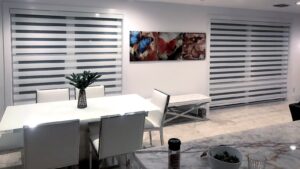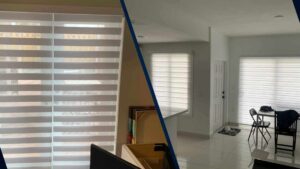Most homeowners struggle not because options are limited, but because they don’t fully understand how blinds and shades function differently. Selecting the wrong type can lead to poor light control, reduced privacy, or mismatched style. The solution lies in clarity. By analyzing performance, material behavior, and usage context, you can confidently align your window treatments with both design and purpose.
This guide offers a structured, side-by-side comparison of blinds and shades from a functional and design standpoint. You’ll learn how each option performs in key categories: privacy, insulation, aesthetics, light management, and long-term maintenance. Whether you’re specifying treatments for a residential upgrade or a new build, this breakdown will help you make an informed, investment-worthy decision.
What Are Blinds? Key Features, Materials, and Applications
Blinds are structured window treatments composed of horizontal or vertical slats, engineered for precise control over light, visibility, and airflow. Unlike fabric shades, blinds are built from hard materials such as wood, faux wood, aluminum, or vinyl. Their defining feature lies in the adjustability of the slats, which can be tilted to modulate light without raising the entire covering.
Key Functional Features
Light Control Precision
The ability to angle slats provides granular control over how much natural light enters a room. This is ideal for environments where both illumination and glare reduction are priorities.
Adjustable Privacy
Blinds allow homeowners to maintain privacy without sacrificing daylight. This is particularly beneficial in urban settings or street-facing windows.
Ventilation Management
The open structure allows for airflow even when the window is partially covered, which is not possible with solid fabric shades.
Modularity
Most blind systems allow for partial or full retraction, making them adaptable to different lighting conditions throughout the day.
Common Materials and Performance
Wood
A premium material choice for formal or traditionally styled interiors. Wood blinds provide natural warmth and texture but are sensitive to humidity, making them less suitable for kitchens or bathrooms.
Faux Wood
Made from PVC or composite materials, faux wood blinds mimic the appearance of real wood while offering superior resistance to moisture. They are durable and ideal for high-humidity areas.
Aluminum
Lightweight, corrosion resistant, and visually sleek, aluminum blinds are popular in commercial and minimalist residential spaces. They offer long-term performance with minimal upkeep.
Vinyl
Cost effective and practical, vinyl blinds are commonly used in rental properties or utility areas. While not as refined in appearance, they offer functional reliability.
Where Blinds Perform Best
Kitchens and Bathrooms
Faux wood and aluminum blinds are excellent choices in high moisture environments due to their resistance to warping and discoloration.
Home Offices
Horizontal blinds provide optimal daylight control while reducing screen glare, making them ideal for productive workspaces.
Living Areas with Direct Sun Exposure
Adjustable slats help protect furniture and flooring from UV damage while allowing ambient light to enter.
Commercial Settings
Vertical and aluminum blinds offer dependable, low maintenance performance in offices, clinics, and retail environments.
Blinds are particularly well suited for those who prioritize adjustability, durability, and a clean linear appearance. They provide a balance of functional control and design consistency across various settings

What Are Shades? Key Benefits, Materials, and Design Impact
Shades are fabric-based window treatments that operate as a single continuous panel. They can be raised or lowered to manage light and privacy but do not include slats like blinds. Shades provide a soft, unified visual presence and are often chosen for their ability to improve energy performance, reduce glare, and integrate easily into a wide range of interior styles.
Key Benefits
Soft Light Filtering
Shades offer uniform light diffusion, making them ideal for spaces where gentle natural lighting is preferred. Depending on the fabric and opacity, shades can either softly illuminate a room or completely block out light.
Superior Privacy and Coverage
Because they are made from solid materials without gaps, shades provide full coverage when lowered. This makes them ideal for bedrooms, bathrooms, or street-facing windows where privacy is essential.
Energy Efficiency
Certain shades such as cellular or honeycomb designs are engineered with insulating pockets that trap air. This helps regulate indoor temperatures, reduce heat gain in summer, and minimize heat loss in winter.
Design Flexibility
Shades are available in a wide variety of fabrics, textures, and colors. Whether the goal is to add subtle softness or create a bold statement, shades can be fully customized to complement any interior design theme.
Common Materials and Fabric Types
Polyester
Durable, fade resistant, and low maintenance. Suitable for high traffic areas and everyday use.
Linen
Offers a natural texture and elegant finish. Best suited for living rooms, dining areas, or relaxed spaces with neutral tones.
Bamboo and Woven Wood
Eco-friendly and rich in texture. Brings warmth and an organic feel to interiors. Often used in boho, coastal, or rustic design schemes.
Cellular Fabric
Purpose built for insulation. The honeycomb structure creates air pockets that significantly improve thermal performance and sound absorption.
Where Shades Perform Best
Bedrooms
Living Rooms and Dens
Sheer or light filtering fabrics enhance ambiance while reducing glare on screens and protecting furniture from UV damage.
Dining Areas
Roman shades or bamboo shades bring elegance and natural texture to spaces designed for comfort and gathering.
Climate Sensitive Zones
In areas like Miami where heat and sunlight are constant factors, cellular shades are highly effective for thermal insulation and light control.
Shades are ideal for homeowners looking to add softness, improve energy efficiency, and integrate a clean modern finish into their interior design. Their simplicity, functionality, and customization options make them a versatile solution across a wide range of applications.

Blinds vs Shades Comparison Table Key Differences at a Glance
While both blinds and shades serve the core function of light control and privacy, their operational design, material composition, and performance characteristics vary significantly. The table below provides a consolidated view of how each option performs across essential categories. This structured comparison is designed to support homeowners, designers, and specifiers in selecting the most appropriate solution for their environment and objectives.
| Feature | Blinds | Shades |
|---|---|---|
| Light Control | High precision due to adjustable slats | Moderate to high depending on fabric opacity |
| Privacy | Adjustable slats allow flexible privacy control | Full coverage when lowered; ideal for complete privacy |
| Material Composition | Hard surfaces such as wood, faux wood, aluminum, or vinyl | Soft fabrics such as polyester, linen, bamboo, or cellular materials |
| Aesthetic Impact | Structured and linear visual presence | Soft, cohesive, and customizable with a broader range of textures |
| Energy Efficiency | Moderate insulation depending on slat material and fit | High insulation potential, especially with cellular and layered designs |
| Maintenance | Easy to clean with a cloth or duster | Requires gentle cleaning or vacuuming depending on fabric type |
| Durability | Highly durable and long lasting, especially aluminum and faux wood models | Varies by fabric; may be susceptible to fading or wear in high-sun areas |
| Cost Range | Generally lower upfront cost | Wider price range depending on fabric type, lining, and automation |
| Recommended Rooms | Kitchens, bathrooms, home offices, commercial spaces | Bedrooms, living rooms, dining areas, and climate-sensitive environments |
Which One Is Right for You Practical Use-Case Recommendations
Understanding the functional differences between blinds and shades is one part of the equation. The more important step is applying that knowledge to real-life use cases. Your decision should be driven by room requirements, environmental conditions, and the overall design intent of your space. Below are practical recommendations based on common residential applications and lifestyle needs.
For High-Humidity Areas (Kitchens and Bathrooms)
Recommended: Blinds
Moisture resistance is critical in these zones. Faux wood or aluminum blinds provide the durability and wipe-clean convenience needed in environments with regular steam or splashes. Their slatted design also allows for ventilation while maintaining privacy.
For Bedrooms and Rest Areas
Recommended: Shades
Privacy and light exclusion are top priorities in sleeping areas. Blackout or dual-layer shades are designed to create complete darkness, regulate temperature, and soften the room’s visual tone. Cellular shades are ideal here for their insulation and sound absorption.
For Workspaces and Home Offices
Recommended: Blinds or Solar Shades
Screen glare and light direction can affect productivity. Horizontal blinds offer adjustable control, while solar shades filter light without obstructing outdoor visibility. The best choice depends on whether you prioritize sharp control or seamless views.
For Open Living and Entertaining Areas
Recommended: Shades
Roller, Roman, or woven wood shades add elegance and texture to shared spaces while offering a clean finish when fully raised. These materials also help soften acoustics and reduce UV exposure on furnishings.
For Large Windows or Sliding Glass Doors
Recommended: Cellular Shades or Solar Shades
Homes in climates with high solar exposure benefit most from materials that manage heat gain. Cellular shades improve insulation and reduce energy costs, while solar shades maintain visibility without compromising thermal comfort.
Conclusion
Selecting the ideal window treatment requires more than aesthetic preference—it demands alignment with function, climate, and daily use. By understanding their distinct advantages, you can specify solutions that enhance comfort, efficiency, and design integrity. For tailored recommendations or professional installation, consult a window treatment expert who can translate your needs into a solution that performs beautifully.




